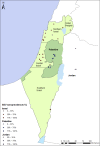Seroprevalence and risk factor analysis for exposure to equine encephalosis virus in Israel, Palestine and Jordan
- PMID: 28713576
- PMCID: PMC5488184
- DOI: 10.1002/vms3.58
Seroprevalence and risk factor analysis for exposure to equine encephalosis virus in Israel, Palestine and Jordan
Abstract
Equine encephalosis virus (EEV) is an orbivirus transmitted by Culicoides species. Most infected horses show mild clinical signs and mortality is usually very low. EEV is closely related and similarly transmitted to other, more pathogenic and economically important, orbiviruses such as African horse sickness virus (AHSV), bluetongue virus (BTV) and epizootic haemorrhagic disease viruses (EHDV), and may serve as an indicator for possible transmission of the latter. Israel has been reported to be endemic for EEV since 2001. This study was initiated to re-evaluate the current seroprevalence and risk factors for EEV exposure in Israel, and to assess, for the first time, the seroprevalence of EEV in Palestine and Jordan. Three hundred and sixteen serum samples were collected from apparently healthy horses at 21 farms in Israel, 66 horses at nine farms in Palestine and 100 horses at three farms in Jordan. The presence of EEV antibodies was detected by a serum neutralization assay. Seroprevalence of EEV was 58.2% (184/316 horses) in Israel, 48.5% (32/66 horses) in Palestine and 2% (2/100 horses) in Jordan. Seroprevalence in Jordan was significantly lower than in Israel and Palestine (P < 0.001). The farm (P < 0.001) and horse age (P = 0.003) were found as significant risk factors for EEV exposure in Israel in multivariable statistical analysis. The results of this study further demonstrate that EEV is no longer limited to South Africa and is endemic in both Israel and Palestine and horses in Jordan were also exposed to this virus emphasizing the potential of pathogens to invade new ecological niches.
Keywords: Equine encephalosis virus; arbovirus; horse; seroprevalence.
Figures



References
-
- Abutarbush S.M., La Rocca A., Wernike K., Beer M., Al Zuraikat K., Al Sheyab O.M. et al (2015) Circulation of a Simbu Serogroup Virus, Causing Schmallenberg Virus‐Like Clinical Signs in Northern Jordan. Transboundary and Emerging Diseases, doi: 10.1111/tbed.12468 - DOI - PubMed
-
- Aharonson‐Raz K., Steinman A., Kavkovsky A., Bumbarov V., Berlin D., Lichter‐Peled A. et al (2015) Analysis of the Association of Climate, Weather and Herd Immunity with the Spread of Equine Encephalosis Virus in Horses in Israel. Transboundary and Emerging Diseases, doi: 10.1111/tbed.12424 - DOI - PubMed
-
- Attoui H. & Jaafar F.M. (2015) Zoonotic and emerging orbivirus infections. Revue Scientifique et Technique (International Office of Epizootics) 34, 353–361. - PubMed
LinkOut - more resources
Full Text Sources
Other Literature Sources

